Richard Coibion was hit by the effects building bug back in 2001. With a background 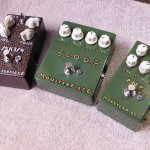 and education in electronics engineering and having a steady career in IT, Coibion dabbled in modifying fuzz circuits and tuned them to his liking. He hadn’t ever considered making a career out of building effects however.
and education in electronics engineering and having a steady career in IT, Coibion dabbled in modifying fuzz circuits and tuned them to his liking. He hadn’t ever considered making a career out of building effects however.
With the post 9/11 economy in the U.S. suffering in late 2001, Coibion’s previously steady IT career was over, and in 2002 he decided to give building effects a try. As an active member of Harmony-Central and other forums, he offered some of his initial designs to forum members. The response was great, word of mouth grew, and Monsterpiece Fuzz was officially born.
Monsterpiece Fuzz designs are heavily focused around – of course – modified fuzz effects. In describing the ideal fuzz tone, Coibion believes a fuzz should be usable, 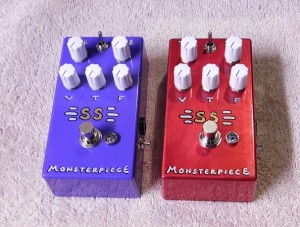 musical, dynamic and responsive. “I don’t particularly care for ‘noise maker’ fuzzes. I view fuzz as an organic, almost living and breathing thing. It’s an instrument unto itself,” he said. “The Monsterpiece NPN, PNP, Ge, Classic, and Scratchy Snatch circuits are all based on the classic Fuzz Face circuit. I have changed things here and there and added some things to fine tune them to what MY ears wanted to hear.”
musical, dynamic and responsive. “I don’t particularly care for ‘noise maker’ fuzzes. I view fuzz as an organic, almost living and breathing thing. It’s an instrument unto itself,” he said. “The Monsterpiece NPN, PNP, Ge, Classic, and Scratchy Snatch circuits are all based on the classic Fuzz Face circuit. I have changed things here and there and added some things to fine tune them to what MY ears wanted to hear.”
Monsterpiece Fuzz builds other models based on famous effects including the Sola Sound MKIII and MKIV Tone Benders and the Colorsound overdrive. A few years ago, when the Klon Centaur was discontinued and out of production, Coibion had received a request to build one as Ebay prices of original Klon Centaurs skyrocketed (Note: they haven’t gone down since!). Building an impeccable layout on a veroboard rather than using the readily-available PCB kits, the STUD overdrive was born.
Other improvements were made to the STUD overdrive as well. The charge pump, a 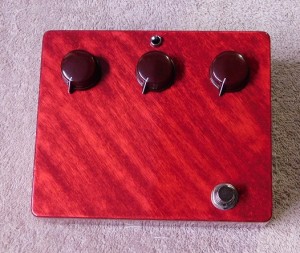 component that internally converts the signal from 9v to 18v for higher headroom, he discovered was noisy, which necessitated making changes to the grounding structure. Coibion also prefers to use an audio taper volume pot rather than the linear taper pot that the original design calls for as he feels linear taper designs can be too abrupt in the sweep.
component that internally converts the signal from 9v to 18v for higher headroom, he discovered was noisy, which necessitated making changes to the grounding structure. Coibion also prefers to use an audio taper volume pot rather than the linear taper pot that the original design calls for as he feels linear taper designs can be too abrupt in the sweep.
“I never intended to build those in the first place,” Coibion said. “The first one I built was just supposed to be a one-off for someone on The Gear Page, but after he got it, he spilled the beans, and everyone else wanted one, too.”
Boutique effects building has become a highly saturated and competitive market, however let’s share a little-known secret. Much of what is being done today and offered and marketed as boutique, really is just mass production using a boutique name. Meaning that in many cases, component quality and other short cuts are taken to drive down costs to maintain competitiveness and scale.
Monsterpiece Fuzz on the other hand intends to stay as one of the last true boutique builders and continues to operate as a one-person shop. Every aspect of a 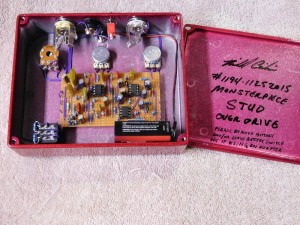 Monsterpiece Fuzz creation, other than the powdercoating of enclosures, is done personally by Coibion. And it’s just how he likes it. It enables him to focus on an area that he is passionate about: the build quality.
Monsterpiece Fuzz creation, other than the powdercoating of enclosures, is done personally by Coibion. And it’s just how he likes it. It enables him to focus on an area that he is passionate about: the build quality.
Open one up and you will see that each pedal is meticulously built by hand with wiring work that is simply breathtaking. This is clean, pure, electronic art. Seeing the attention to build quality like this reminds me of the legendary Dave Reeve’s era of Hiwatt amplifiers (used by the Who, Pink Floyd and others), built with ultra-clean, military spec layouts. If you haven’t previously seen the inside of an early Hiwatt Custom 100 DR-103, check out our earlier post.
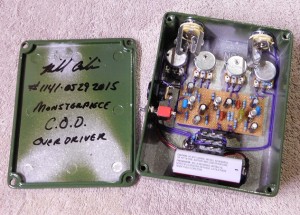 One of Coibion’s goals is to keep his pricing fair and reasonable for customers who want to use his products. There is a LOT more time and effort that needs to go into handwiring and building a pedal with the detail that’s found inside a Monsterpiece Fuzz creation. Most Monsterpiece Fuzz models can be purchased for the same price, or sometimes less, than similar boutique-labeled designs that are mass produced today.
One of Coibion’s goals is to keep his pricing fair and reasonable for customers who want to use his products. There is a LOT more time and effort that needs to go into handwiring and building a pedal with the detail that’s found inside a Monsterpiece Fuzz creation. Most Monsterpiece Fuzz models can be purchased for the same price, or sometimes less, than similar boutique-labeled designs that are mass produced today.
Coibion attributes his success to love for the craft and for having an ear for tone. “I make pedals because I really enjoy doing it. I make pedals that I personally would want to use, and sound the way I imagine in my head they should sound,” said Coibion before adding, “I’m just glad other people’s ears seem to agree with mine!”
His success, of course, isn’t defined by revenue and growth of sales, but by his ability to maintain a steady and consistently sized small business doing what he loves.
“I’ve witnessed a lot of builders come and go, and the ones that do stick around for at least as long as I have for the most part have outgrown what they were in the beginning. Me, I am just as small as I ever was. I like it this way.”
Visit Monsterpiece Fuzz and see what Richard Coibion can build for you.